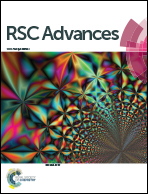Photogalvanic cells: comparative study of various synthetic dyes and natural photo sensitizers present in spinach extract†
Abstract
Photogalvanic cells (PG) are dye sensitized solution based solar power generation and storage devices. The photogalvanics of various synthetic dyes (single/mixed) and natural photo sensitizers (present in crude spinach extract) has been studied to obtain some new insights with the aim of finding relatively cheaper, cleaner and environmentally friendly photo sensitizers for further improvement in the electrical performance of PG cells. In this study, at illumination intensity 10.4 mW cm−2, the observed value of electrical output for single as well as mixed photo sensitizers is of the same order, and surprisingly very high with respect to earlier reported results. Therefore, it may be concluded that mixed photo sensitizers do not offer any significant advantage over single photo sensitizers. Therefore, I suggest a focus on single photo sensitizers, and more on natural photo sensitizers like chlorophyll present in crude spinach extract for cost-effective, eco-friendly and renewable cells.


 Please wait while we load your content...
Please wait while we load your content...